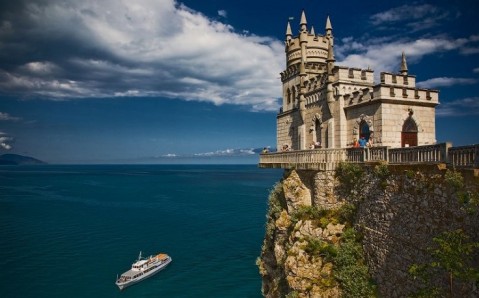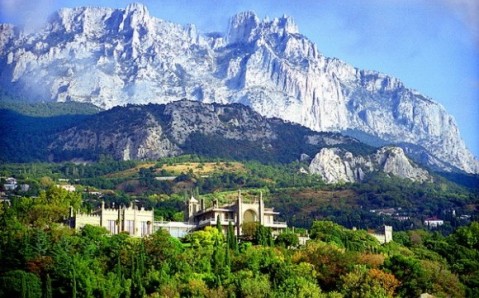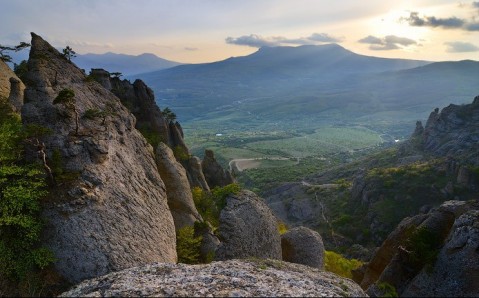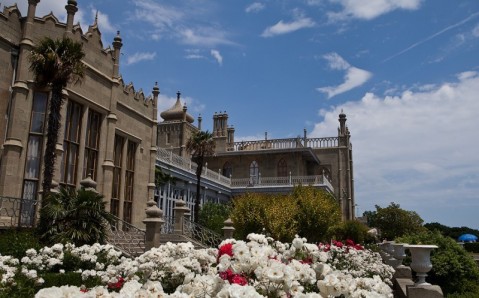Swallow's Nest
•
Yalta (42 km.)
Swallow's Nest
•
Yalta (42 km.)
The tiny Gothic castle is set, like a swallow’s nest, on the steep Cape of Ai-Todornot cliffs, far from Yalta. It is one of Crimea’s best known trademarks. This elegant building is reminiscent of the castles on the banks of the Rhine, and is considered to be one of the most interesting architectural and historical monuments on the peninsula.
The castle, which at first used to be wooden, got its u
Nikitsky Botanical Garden
•
Yalta (41 km.)
Nikitsky Botanical Garden
•
Yalta (41 km.)
Located not far from Yalta, the Nikitsky Botanical Garden is a real outdoor museum, one of the most unique landmarks of southern Crimea. This man-made park is recognized as a masterpiece of landscape art and is one of the oldest and the most famous botanical gardens in the world. It is rightfully called the ‘green treasure’ of the peninsula: unique types of plants from all regions of the planet ar
Ai-Petri
•
Yalta (38 km.)
Ai-Petri
•
Yalta (38 km.)
Ai-Petri (Greek for ‘Saint Peter’) is one of the most famous Crimean mountaints. Its picturesque peaks, which fence off Yalta from the outer world, have become the symbol not just of the southern coast, but also of the entire Crimean peninsula.
This legendary massif is attractive for tourists because from its peaks, one can get an amazing view over the whole southeastern coast of Crimea. In order
Chatyr-Dag
•
Alushta (38 km.)
Chatyr-Dag
•
Alushta (38 km.)
The Chatyr-Dag mountain massif is one of most famous and most visited in Crimea. It is one of the five tallest mountains on the peninsula, standing at over one and a half thousand meters (4,920 feet) high. In clear weather, you can see nearly all of Crimea from the top of Chatyr-Dag. The name of the massif is translated from the Turkic as ‘tent-mountain,’ and from afar, this stone giant’s silhouet
Vorontsov Palace
•
Yalta (41 km.)
Vorontsov Palace
•
Yalta (41 km.)
This architectural monument to Romanticism is one of the shiniest pearls in the necklace that is Crimea. Created by people in tandem with nature, the Vorontsov Palace has amazed guests with its original look for almost two centuries.
The Palace was build in the middle of the 19th century as summer residence of Russian statesman, Prince Mikhail Vorontsov, who was the governor-general of Russia’s s
Livadia Palace
•
Yalta (40 km.)
Livadia Palace
•
Yalta (40 km.)
The white-stone Livadia Palace, which served as a summer residence for Russian emperors in the 19th - 20th centuries, is not just the most beautiful architectural installation of Crimea’s southern coast, but also an important historical monument. Here, Allied leaders defined the fate of the post-WWII world.
The history of the palace began in 1834, when Polish magnate Lev Potockiy bought the tiny
Chersonesus
•
Sevastopol (32 km.)
Chersonesus
•
Sevastopol (32 km.)
This unique monument of antiquity is one of the brightest tourist attractions on the Crimean peninsula. It is recognized as one of Seven Wonders of Ukraine, and it is nominated to be included on UNESCO’s list of World Heritage Sites.
Chersonesus is an ancient city, founded over two and a half thousand years ago by Greek colonists. These ancient inhabitants chose a very favorable place to settle:
Balaklava
•
Sevastopol (35 km.)
Balaklava
•
Sevastopol (35 km.)
Balaklava is a small town near Sevastopol, nestled on the coast of an extremely beautiful bay. This serene harbor, hidden from strangers’ eyes by jagged mountains, is a unique piece of nature. Due to its favorable location it, it sheltered different peoples for thousands of years, and in the post-WWII period, it became a secret base for Soviet submarines. Today, Balaklava, with its amazing landsca

 Crimea
Crimea








